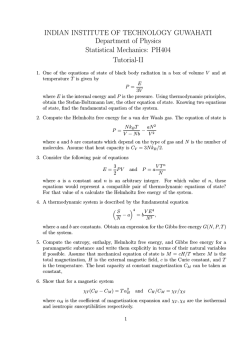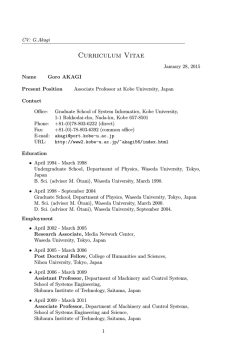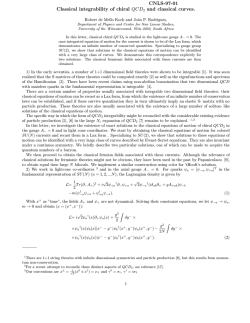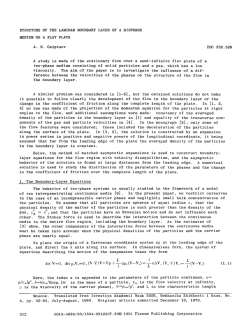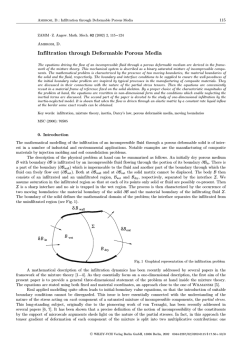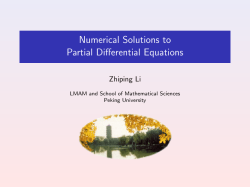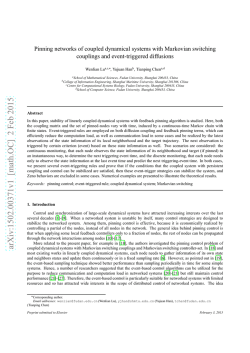
Stability and periodicity in coupled Pinney equations
JOURNAL OF DIFFERENTIAL Stability EQUATIONS loo, and Periodicity 82-94 (1992) in Coupled Pinney Equations C. ATHORNE Department of Mathematics, University Gardens, Glasgow University, Glasgow GI2 8Q W, United Kingdom Received May 16, 1990; revised November 24, 1990 We show that the coupled Pinney equations with periodic coefficient constitute a class of nonlinear, coupled Hill’s equations for which the problems of stability and periodicity of the solutions reduce to those for a pair of uncoupled, linear Hill’s equations, one of which is of Ince type. 0 1992 Academic Press, Inc. 0. INTRODUCTION In a previous publication Cl] it has been shown that a rather general class of coupled, second-order, nonlinear equations of the form d2x --g+w2(f)x=x-3f(x/y) (1) d2y ;i;r+w*wv =Y-3g(Y/x) can be reduced to a pair of independent, linear equations. Here o, J and g are essentially arbitrary functions of their arguments and (1) constitutes a significant subclass of the class of so-called Ermakov systems [ 15, 16). These systems orignated in the late 19th century, in the work of V. P. Ermakov who studied the case g =0 from the point of view of invariant theory [4]. They have since found application in quantum mechanics [lo], elasticity [19], and optics [9]. There is an extensive literature on such systems (see the referencesin Cl]). The linearization exploits two observations. First, one may autonomize the system (1) provided one knows the general solution to the linear equation, d2x z + d(t)x = 0. Secondly, the system possessesa first integral of first order, the Lewis-RayReid invariant [15, 163. One reduces the order of the system (1) by two, 82 0022-0396/92$5.00 Copyright 0 1992 by Academic Press, Inc. All rights of reproduction in any form reserved. C. ATHORNE 83 using these observations, and it transpires that the resulting system is a single, linear equation of second order. Together with (2) this constitutes the linear pair. However, the correspondence between solutions of (1) and solutions of the linear system is not trivial. In this paper we discuss this correspondence for a two parameter family of Ermakov systems, the coupled Pinney equations: d2x ~+w2(f)X= -crxy-4+px-3 (3) d2y dt’+w2(t)y= -yyr4+6yp3. We assume that 02(t) is periodic of period rc and that CC,j, y, and 6 are nonnegative with c1+ 6 and fl+ y nonzero. Then we may scale x and y by real, positive constants in order to make CI+ 6 =/I + y = 1 and we shall assume this done in what follows. The coupled Pinney equations arise in the theory of two-layer, shallow water waves [18]. In particular, an ansatz is chosen where the velocities are linear and the depths quadratic in the horizontal displacements. The t-dependent coefficients, under a further restriction analogous to that employed in [20], then satisfy the system (3) but with 02(t) = 4. The physical restrictions on c(, /I, y, and 6 are consistent with those assumed in (3). The more general situation where w2(t) is periodic in t ought to model a weakly periodically forced two-layer shallow water wave system. In this case the linearization leads to a pair of Hill’s equations with coefficients of period K [21], one of which is an Ince equation [12]. The questions classically posed for Hill’s equations are those of existence and coexistence.The question of the existence of a periodic solution, necessarily of period n7~for n E N, reduces in general to an infinite determinantal condition. The question of the coexistence of another, linearly independent periodic solution is answered in the affirmative if n > 2. For n < 2 the coexistence question is tricky. Ince equations are important becausein their case the coexistence question can be settled by tinite, algebraic means. In retracing our steps from a solution of the linear system to a solution of the nonlinear system, we encounter problems due to the singularities of the linear system and due to the autonomizing procedure. We shall show that stability (periodicity) of the general solution to the linearized system is sufficient for stability (periodicity) of solutions to the nonlinear system having a given value of the Lewis-Ray-Reid invariant. This is not the general solution: changes in the inital conditions which alter the value of the invariant will alter the character of the solutions. Apart from the motivation provided by the applications of such systems, 84 COUPLED PINNEYEQUATIONS the coupled Pinney equations provide a simple, nontrivial example of a Ermakov system, where global information about the dynamics can be extracted from the linearization procedure. 1. THE PINNEY EQUATION In order to prepare the ground we consider first the Pinney equation itself, d2x dii+02(t)x=x-3. (4) The general solution is x(t) = (Ax; + 2Bx,xa + Cx;)“*, (5) where x,(t) and x2(1) are any linearly independent solutions to the linear equation (2) having unit Wronskian and where A, B, and C satisfy the condition AC - B* = 1. This solution is somewhat tersely presented in [ 141 but it can be derived in an illuminating way using some projective geometry. Recall [ 1I] that the most general transformation which preserves the class of n th order, homogeneous, linear ordinary differential equations, d”-‘x -df-1 d”x -p+Pl(t) + ... +p,(t)x=O (6) is, t + 4th x + u(t)x. (7) By such a transformation one may remove p1 and p2, provided one can solve a single Riccati equation involving p2(t), to arrive at the ForsythLaguerre canonical from [S]. The residual symmetry group of the canonical form is s+- a + bs c+ds’ x-+(c+ds)p”+lx, where the constants a, b, c, and d satisfy bc - ad= 1, together with a constant scaling of x. This is also true for classes of nonlinear ordinary differential equations [3] amongst which we find, 85 C. ATHORNE In particular, if x1 and x2 are linearly independent solutions of (2), the transformation, x = x,(t)x(s) s = x1(t)x;‘(t), (10) reduces (4) to the autonomous from, d=X -=2xds= 3 (11) provided x1 and x2 have unit Wronskian. Equation (11) is invariant under the homographic transformation, s-+s’=- a + bs c+ds’ ,f.+X’=- x c + ds (12) with bc - ad = 1. The autonomizing transformation is valid only away from zeros of x,(t). Near such zeros we must make a different choice of linearly independent solutions to avoid this problem. Each choice gives a different afftne representation of the projective line and all such representations are related by homographic transformations (12). Hence we solve (11) by quadrature on any pair of distinct afline representatives of the projective line, with afline coordinates s and s’, to obtain local solutions, X(s) = (A + 2Bs + CS=)~‘=, s#oo X’(s) = (A’ + 2B’s + C’s’=)li2, s’ = co (13) with AC- B2 = A’C’- B” = 1. These local solutions patch together under (12), provided A, B, C and A’, B’, C’ are suitably related, to give the general, global solution (5). 2. THE COUPLED PINNEY EQUATIONS For the coupled Pinney equations (3) the same autonomizing transformation, supplemented with y(t) = x2( t)jj(s), is efficacious and for the same reasons. Therefore we desire to integrate the pair, d2X -= ds2 d=j -g= -aq-4 +/3x-’ (14) -yjL-4+6y-3. 86 COUPLED PINNEY EQUATIONS The substitutions X2= X, y* = Y, and z = X/Y lead to x2-i g (“> 2= -2cxz*+2p Y$-; $ (7 2= -2yzr*+2iS. (15) Now take z as an independent variable and write p = dX/ds, q = dY/ds to obtain, From these equations one obtains the first integral, p-qz=h(z)~2z”*(I-z-z-‘}“2 (17) so that (16) is actually a pair of independent Riccati equations. The constant I, on which h(z) depends, is already known as the LewisRay-Reid invariant [ 15, 161. It is a rational function of the projective invariants z and p - zq (see below). Finally, put $ = Y- ‘j2, cp= X-ii2 so that dcpfdz= -pcp/2zh and d$/dz = -q$/2h are the usual linearizing transformations for Riccati equations. This gives the self-adjoint, linear equations, hd211, I dh& I -ij=o dz*-Y (18) zhd*vI -WI 4 +~ B- m*cp=o, (19) dz2 dz2 dz dz dz dz z2h zh where $‘=z(p*. Hence the nonlinear equations (3) are reduced to the linear pair consisting of (2) and either (18) or (19). One may construct, in principle, the general solution to (3) from that of the linear pair [ 11. Equations (14) have a residual symmetry group given by (12) together with j + jj/(c + ds) which induce transformations of z, p, and q, z + z, 2dX P’P-c+ds’ 2dY q+q-c+ds (20) leaving z, p-qz, and Eq. (16) invariant. The corresponding transformations on the variables z, $, and cpare z + z, II/ + (c + ds)$, cp+ (c+ ds)cp. (21) 87 C.ATHORNE Regarding s as a function of z defined, away from singularities, by the equation, dz p-qz z=-T- (22) one seesthat (21) leaves (18) and (19) invariant as is expected. For, in the case of (19), for instance, the difference between the transformed and untransformed equations is, d(zh) Yd cp+--’ dz p-qz ‘= which vanishes by the definitions of cp2and h. As a useful consequence of this invariance, suppose cp is a solution (locally) to (19). Then (c + ds)cp is also a solution, and (c+ds)cp=c,cp+c,cp,* (24) where (p* is some linearly independent solution to (19). If then S(Z)-+ 00 as z + z0 on any contour where the general solution to (19) is bounded we must have cp(zO)= 0. Conversely, if z0 is a zero of cpand d # 0 then c2# 0 and cp*(z,) ~0, so that S(Z)cp is bounded and nonvanishing as z + zW Hence, LEMMA 1. On any contour in the z-plane, not containing singular points, on which the general solution to (19) is bounded, s(z,,) = CC zf and only if 4GcJ = 0. Further, if (2) is nonsingular for the range of t considered, the two linearly independent solutions xl(t) and x*(t) cannot simultaneously vanish. Then x(t) = x,(t) cp- 7s) = x1(t)(scp(s))-’ cannot vanish at zeros of x2 since s = co there and scp(s) is finite and nonzero. Similarly, it cannot vanish at zeros of x,(t). Also, since cp is bounded, x(t) is of one sign. The same applies for y(t). The lemma will also apply on contours where cphas, say, only elementary regular singular points (Fuchsian exponents 0 and i [6]). The following lemma assures us that near ordinary and elementary regular singular points of (18) and (19) we can invert the linearization to obtain X(s) and j(s). LEMMA 2. Zf z0 is an ordinary point of (18), (19), and cp(zO)# 0, then X(s) and j(s) are analytic and nonvanishing functions for s - s0 in neighborhood of 0, where s,, is arbitrary. Zf cp(z,,) =O, then X(s), j(s) have the form (S-Q,) @(s-ss,), where @(s-s,) is analytic and nonvanishing for s in a neighborhood of 00. In the case where z0 is an elementary regular singular 88 COUPLED PINNEY EQUATIONS point of (18), (19) the same conclusions apply but Q, becomes a function (s - s(J2. of The first part of this lemma (ordinary points) is proved in [ 11. Similar arguments suffice for the second part. 3. REDUCTION TO HILL'S EQUATIONS, STABILITY, AND PERIODICITY Equations (18), (19) are Fuchsian [6] with regular singular points at 0, ~0, zl, and z2, the last two being the roots of h’(z) = 4(z - z1)(z2 -z) = 0 and are, when distinct, elementary regular singular points. We transform three of these singular points to 0, co, and 1 using the Mobius transformation z = (z2 + (z, - z2) w))‘, d2v -dw2 2w-1 d’P+kK(Z2+(Z,-Z2)W)~2 4w(l -w) 2w( 1 - w) dw cp=o. (25) This is the Lindemann form [21] of the Ince equation, 4cr cp=o, Z2(1 + a cos 20)2 (26) where w = cos28. The constant a is given by, a=(1 -4/Z2)‘j2. (27) The Lewis-Ray-Reid invariant is (28) which is bounded below by the value 2, since x and y are real. The roots of h2(z) are both then real and positive, and unequal provided I> 2. In that case Ial < 1 and (26) is free from singularities on the real axis. From this we deduce that the motion is confined to the wedge z1 ,< z < z2, the boundaries being the elementary singular points of (18), (19), and that, at these boundaries, p-qz=O, i.e., the trajectories are tangent to the boundaries. In the case I= 2, p = qz on the whole trajectory and the wedge degenerates into a single ray. From now on we will assume that the general solution to (2) is periodic of period T, a multiple of R, and that there are n zeros per period. By the Sturmian theory [6] the zeros alternate for any pair of linearly independent, real solutions x,(t), x,(t), zeros never coincide and no solution has a zero of order greater than one. Then s = xl(t) x;‘(t) is a monotonic function of 89 C. ATHORNE t. We take s’ = x1(t) x;‘(t) also monotonic. As t passesthrough a period T, the variables s and s’ define an n-fold covering of the real projective line. For certain equations (2) (see below) it may be that the projective variable has period T/2. We shall assume for the moment that s has period T. Now suppose that the general solution to (26) is stable (in the senseof Floquet theory [21]) and oscillatory. On the coordinate patches s # cc and s’#co we have x(t)=x,(t)cp-‘(s) and x(t)=xi(t)cp’~‘(s’), respectively, where cp’(s’)= scp(s) and s’ = s - ’ on the intersection of the coordinate patches. The only places where x may vanish are at s = cc or s’ = co but this does not happen (Lemma 1). So x(t) is bounded away from 0 for all time. Likewise, by Lemma 1, x(t) is bounded away from co for all time. Since z is bounded by the wedge z, Q z < z2, the same is true of y(t). Hence, under our general assumptions, stability of the general solution to the Ince equation (26) is sufficient for stability of the corresponding class of solutions (i.e., of given value for I) of the coupled Pinney equations (3). One may see this point clearly in a geometrical fashion. Suppose (pi(e) and (p,(8) are solutions of (26) corresponding to the pair of autonomizing substitutions x(t) = x,(t) X(s) = x*(t) X’(s’), respectively. The trajectory (xi(t), x2(t)) is a closed orbit in R2 encircling the orgin n/2 times. If the general solution to (26) is stable and oscillatory then ((pi(Q), (~~(8)) is a trajectory in R2 bounded within an annulus of finite width encircling the origin. Because s=x,x;‘=cp,cp;’ corresponding points on these two trajectories have the same polar angle. The intersections of the associated radial line with the t-orbit and the @annulus are bounded away from the orgin and from infinity. Consequently, the same is true for x(t) = x1(t) cp; l(0), say. This conclusion is also true under the weaker assumption that the general solution to (2) is Floquet stable and oscillatory. In order to put values on the bounds of x(t) and y(t) it would appear that one needs to know more about the solutions to Ince equations, at least. Now suppose that the general solution to (26) is periodic in 8 of period qn with m zeros per period. By the transformations leading from (19) to (26), z is of period rc in 0, oscillating back and forth in the wedge z,<zdz,. As z describes q circuits of the wedge, q(z) goes through one period. From (22), ds/dO = cp-’ and we see that 9 is a monotonic function of s and since zeros of cpare in one-to-one correspondence with the points s(t) = co, one period of cp corresponds to an m-fold covering of the real projective line. Since each period of s(t) corresponds to an n-fold cover of the projective line, we see that the trajectory (x(t), y(t)) of (3) has period, s=(m,n) T, (29) where ( . , . ) is the 1.c.mof its arguments. Note that this result is independent of the period of cpitself. Hence we state a theorem: 90 COUPLED PINNEY EQUATIONS THEOREM. Assume the general solution to (2) is periodic. If the general solution to the Ince equation (26), for given values of /?, ~1,and I, is stable (periodic) then the solutions of the coupled Pinney equations for those values of B and a, and for which the invariant has the given value, are also stable (periodic, of period given by (29)). It is not clear whether these sufficient conditions may, in fact, be necessary,.since one may imagine a fine tuning of stable, nonperiodic solutions to (2), (26) which gives rise to a periodic solution (3). As an application of these arguments, which however does not strictly fall within the purview of this theorem we consider the degenerate case o’(t) = 1 where s = tant has one zero and one pole per period, z If, further, a = 0 then one of Eq. (3) is decoupled and (26) becomes, d2v -#+&=O. Then cphas period 2nbP iJ2 which is commensurable with the period of z in 8 iff B”’ E Q. The degeneracy of (30) slightly complicates matters in that the period of cpmay be other than an integral multiple of rr. Nevertheless, let b = (p/q)2. The period is 2xq/p with two zeros per period. (p2has period nq/p with one zero per period. Since x(t) is nonvanishing, it is this period which is important. Since q and p are taken to be coprime, p periods of (p2 correspond to q periods of z. Hence the period is px with respect to t. In one such period z oscillates q times in the wedge. These results are borne out numerically as well as by an analytic check [2] independent of the linearization. The period is also consistent with the choice of T = z, m =p and n = 1 in (29). 4. CONCLUSIONS We have exploited a linearization of a class of coupled, second order, nonlinear Hill’s equations to reduce the questions of sufficient conditions for stability and periodicity to those for a decoupled pair of linear Hill’s equations, one of which is an Ince equation. In the linear case these questions are not in general analytically tractable except in respect of solutions of finite order [7] and the coexistence problem in the case of Ince equations [8, 121. In Figs. 1 and 3 periodic solutions of periods 67rand 8x respectively have been located numerically for specific values of a and /? with 02(t) = a. In Figs. 2 and 4 the values of Z have been altered by perturbing the initial condition, destroying periodicity but not stability. The projections into the x-y plane are Lissajous-type figures. 91 C. ATHORNE X-Y i 1 % x-i 1 Data Imt Alpha = 1 - Beta : lal Y ; y i (5/6) (5/6) ~2 +2 Condlt = 1.0000 = 0.0000 = 1.3600 = 0.0000 Ions FIG. 1. A periodic solution of period 6n for the coupled Pinney equations with o2 = l/4, G(= 1 l/36 and p = 25136. Data Imt Alpha = I Beta = la1 x ; y 9 - (5/61+2 (5/61 Condlt : 1.0000 : 0.0000 = 1.3900 = 0.0000 r2 ton, FIG. 2. Part of a quasiperiodic solution for the coupled Pinney equations with CO’= l/4, a = 1 l/36, and /I = 25/36 with an initial condition close to the periodic solution of Fig. 1. 92 COUPLED PINNEY EQUATIONS ALpha = I Bet a inlt (S/6) 12 = (S/61 +2 tal Condlt x = I. 0000 i = 0.9350 Ion! y = 1.0000 i = 0.0000 FIG. 3. A periodic solution of period 8z for the coupled Pinney equations with 0~2~ l/4, OL= 1 l/36, and j = 25136. Data Inlt Alpha = I - Beta = (S/6) ~2 (S/6) t2 lal Condlt x = I. 0000 ; : 0.9500 Ion’ y = 1.0000 9 = 0.0000 -I Part of a quasiperiodic solution for the coupled Pinney equations with m2 = l/4, a = 1l/36, and B = 25/36 with an initial condition close to the periodic solution of Fig. 3. FIG. 4. C.ATHORNE 93 It should be noted that whilst the appearance of these trajectories is like those of an integrable Hamiltonian system, the coupled Pinney equations are not Hamiltonian except when a = 36, y = 30. Further, this single Hamiltonian case is not integrable: every trajectory is unstable. Two comments are in order. The present linearization, and, indeed, that of the more general Ermakov systems, differs from, say, the classical linearization of the Riccati equation in that the latter is an integrable equation in the analytic sense: its only moveable singularities in the complex plane are poles [13]. All other algebraic and essential singularities are fixed and determined by the singularities of the t-dependent coefficients appearing in the Riccati equation. These things are reflected in the fixed nature of the singularities in the linearization. However, this is not so in the case of the Ermakov systems. The singularities of the linearization are indeed fixed, but fixed in the z-plane and hence moveable in the extended phase space of the original equations. In addition, the linearized equations contain as a parameter the Lewis-Ray-Reid invariant, 1, whose value is fixed by the initial conditions. Generally speaking, singular points in the linearization of regular and irregular characters are translated back into moveable singular points of similar character. This leads to our second comment. For given values of b and a, (26) represents a family of equations indexed by the values of I. As I changes one will in principle encounter intervals of stability and of instability. Within the intervals of stability there will be isolated points of periodicity. Small changes in I will then produce qualitative changes in the solution as illustrated in Figs. 14. All solutions in the given codimension one manifold defined by a level set of I will have the same character. An arbitrarily small perturbation to some other level set stands to alter this character, perhaps drastically. It is interesting to have an example of a nonlinear Hill’s system to which the linear theory can be directly applied. ACKNOWLEDGMENTS The author thanks Jon Nimmo and Andy Osbaldestin for stimulating conversations and for numerous numerical experiments, particularly the former for setting up the package which produced the figures in this paper. REFERENCES C. ROGERS, U. RAMGULAM, AND A. H. OSBALDESTIN, On linearization Ermakov system, Phys. L&t. A 143 (1990), 207-212. 2. C. ATHORNE, On a subclass of Ince equations, J. Phys. A 23 (1990), 137-139. 1. C. ATHORNE, SO5/100/1-7 of the 94 COUPLED PINNEY EQUATIONS 3. L. M. BERKOVICH AND N. KH. Rozov, Some remarks on differential equations of the form y” + a,(x) y = q(x) y’, Differential Equalions 8 (1972), 1602-1612. 4. V. P. ERMAKOV, Transformation of differential equations, Univ. Izu. Kiev 20 (1880) 1-19. 5. A. R. Fo~su-nr, Invariants, covariants and quotient-derivatives associated with linear differential equations, Phil. Trans. 179 (1888), 377489. 6. E. L. INCE, ,“Ordinary Differential Equations,” Dover, New York, 1956. 7. E. L. INCE, A linear differential equation with periodic coelhcients, Proc. London Math. Sot. (2) 23 (1923), 5674; The real zeros of solutions of a linear differential equation with periodic coefficients, Proc. London kfufh. Sot. (2) 25 (1924) 53-58. 8. E. L. INCE, The periodic Lame functions, V, Proc. Roy. Sot. Edinburgh Sect A 60 (1940), 47-63; Further investigations into the periodic Lame functions, VII, Proc. Roy. Sot. Edinburgh Sect. A 60 (1940) 83-99. 9. R. A. LEE, Quantum mechanics as a multidimensional Ermakov theory, J. Phys. A 17 (1984), 535-546. 10. H. R. LEWIS, JR., Class of exact invariants for classical and quantum time-dependent harmonic oscillators, J. Math. Phys. 9 (1968), 19761986. 11. S. LIE, Leipziger Berichfe (1894), 322. 12. W. MAGNUS AND S. WINKLER, “Hill’s Equation,” Dover, New York, 1979. 13. M. P. PAINLEVB, “Lecons sur la theorie analytique des equations differentielles,” Hermann, Paris, 1897 14. E. PINNEY, The nonlinear differential equation y” +p(x) y’ + cy-j = 0, Proc. Amer. Math. Sot. 1 (1950), 681. 15. J. R. RAY AND J. L. REID, Noether’s theorem, time-dependent invariants and nonlinear equations of motion, J. Mufh. Phys. 20 (1979), 2054-2057. 16. J. R. RAY AND J. L. REID, More exact invariants for the time-dependent harmonic oscillator, Phys. Left. A 71 (1979), 317-318. 17. J. L. F&ID AND J. R. RAY, Nonlinear superposition, higher-order nonlinear equations, and classical linear invariants, J. Muth. Phys. 23 (1982), 503-509. 18. C. ROGERS, On a Ermakov system in two-layer long wave theory, “Research Report, Department of Mathematical Sciences,” Loughborough University of Technology, 1989. 19. M. SHAHINW~R AND J. L. NOWINSKI, Exact solution to the problem of forced large amplitude radial oscillations of a thin hyper-elastic tube, Infernat. J. Non-Linear Mech. 6 (1971), 193-207. 20. W. C. THACKER, Some solutions to the nonlinear shallow-water wave equations, J. Fluid Mech. 107 (1981), 499-508. 21. E. T. WHITTAKER AND G. N. WATSON, A course of modern analysis, Cambridge Press, London, 1988.
© Copyright 2025
